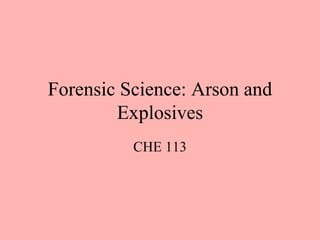
Arson, Explosives, and Ballistics in Forensics
- 1. Forensic Science: Arson and Explosives CHE 113
- 2. Fire • Rapid Oxidation of chemicals to release energy (usually as heat, light, noise) • Difference between combustion and explosion is mostly the rate of the reaction: – Combustion slower – explosion fast
- 3. Oxidation Reactions • Is the combination of oxygen with other substances to produce new substances • Are reactions that exothermic (give off heat) • Involve both oxidation and reduction • Not all oxidation reactions result in flames! – rusting – metabolism • Transfer of electrons – Gain electrons – reduction – Lose electrons - oxidation • Rate of reaction determines the nature of the reaction • Chemicals that supply oxygen (lose electrons) are known as oxidizing agents
- 4. Requirements for Combustion 1. A fuel must be present 2. Oxygen must be available in sufficient quantity to combine with the fuel 3. Heat must be applied to initiate the combustion and sufficient heat must be generated to sustain a reaction. • Ignition temp is the minimum temperature at which fuel vapor will ignite Accelerant: any material used to start or sustain a fire.
- 5. Components for Combustion • Components needed for starting, growing and sustaining a fire: – Heat • auto-ignition temperature (or kindling point) minimum temperature where a substance will spontaneously ignite without an external ignition. • flash point: lowest temperature where a fuel will vaporize sufficiently to form an ignitable mixture with air. – Fuel • flammability limits: air/fuel mixtures beyond these limits, combustion cannot be sustained – Oxygen (oxidizer) – Chain-reaction
- 6. Components for Combustion • Components needed for starting, growing and sustaining a fire: – Heat – Fuel – Oxygen (oxidizer) – Chain-reaction
- 7. Components for Combustion • Fire Suppression: – Heat Suppression – Fuel Suppression – Oxidant Suppression – Chain-reaction Suppression
- 8. Spontaneous Combustion • A natural heat-producing process that may give rise to a fire in the presence of sufficient air & fuel – Ex.) hay stored in barns growing medium for bacteria which generate heat – Ex.) rags soaked w/ highly unsaturated oils, such as linseed oil – Ex.) Not people
- 9. Examination of evidence recovered from an arson • Presence of gasoline, kerosene or turpentine in debris • Liquid gasoline may be compared for origin • Criminalist may be able to reconstruct the ignition mechanism used
- 10. Arson Investigation Arson is the criminal act of intentionally setting fire without lawful consent • Fire Pattern • Debris • Fire Growth and features • Accelerants • Other
- 11. Arson Investigation Arson is the criminal act of intentionally setting fire without lawful consent • Fire Pattern • Debris • Fire Growth and features • Accelerants • Other
- 12. Gasoline Residues • Are best characterized by gas chromatography • Hydrocarbon: any compound consisting only of carbon and hydrogen • Thin-layer chromatography is also useful for screening debris • Unevaporated gasoline • 90% evaporated gasoline • Unevaporated kerosene • 90% evaporated gasoline
- 13. Explosives: Energetic Materials • Definitions – Compounds that react very quickly to produce heat, light, and the rapid outward expansion of gasses – Time is key! • Types – Chemical and Physical • High explosives - explosive charge that reacts at a speed greater than 1,000 m (1094 yards) per second • Detonation - high explosives yielding supersonic pressure waves (shock waves faster than the speed of sound, 343 m/s). • Low explosives - reactions that occur at rates ofless than 1,000 m/sec. • deflagrations - propagated mainly by a flame front rather than a supersonic shock wave .
- 14. Explosives: Energetic Materials • Requirements – Must contain fuel AND oxidant • Separately: ANFO (ammonium nitrate/fuel oil explosive) • Together: TNT • Types – Primary: sensitive to heat, flame, shock or friction and typically detonate quickly – Secondary: relatively stable to heat, shock, electrical discharge, and friction and usually require much more energy to detonate
- 16. Primary (Initiating) High Explosives used in detonators • Lead azide, lead styphnate and diazodinitrophenol – Major ingredient of blasting cap – Not used as main charge b/c so sensitive; however, are used to detonate noninitiating explosives • PETN (pentaerythritol tetranitrate) • TNT (trinitrotoluene) • Dynamite • Smokeless powder (nitrocellulose)
- 17. Damage from High Explosives • Shock Wave • Heat • Flying Debris
- 18. Damage from High Explosives • Shock Wave • Heat • Flying Debris
- 19. Low Explosives & Black Powder • Explosive with a velocity of detonation less than 1,000 meters per second. • Ex.) • PETN (pentaerythritol tetranitrate) • TNT (trinitrotoluene) • Dynamite • Smokeless powder (nitrocellulose)- nonmilitary issued • Black powder • Black Powder ingredients: potassium nitrate, carbon & sulfur • Potassium chromate + Sulfuric acid + sugar can create a low explosive
- 20. Military Explosives: High Explosives • RDX (cyclotrimethlylenetrinitramine) the most powerful & popular – In the form of pliable plastic of dough-like consistency composition C-4 • PETN is used in TNT mixtures for small-caliber projectiles and granades
- 21. End Arson and Explosives